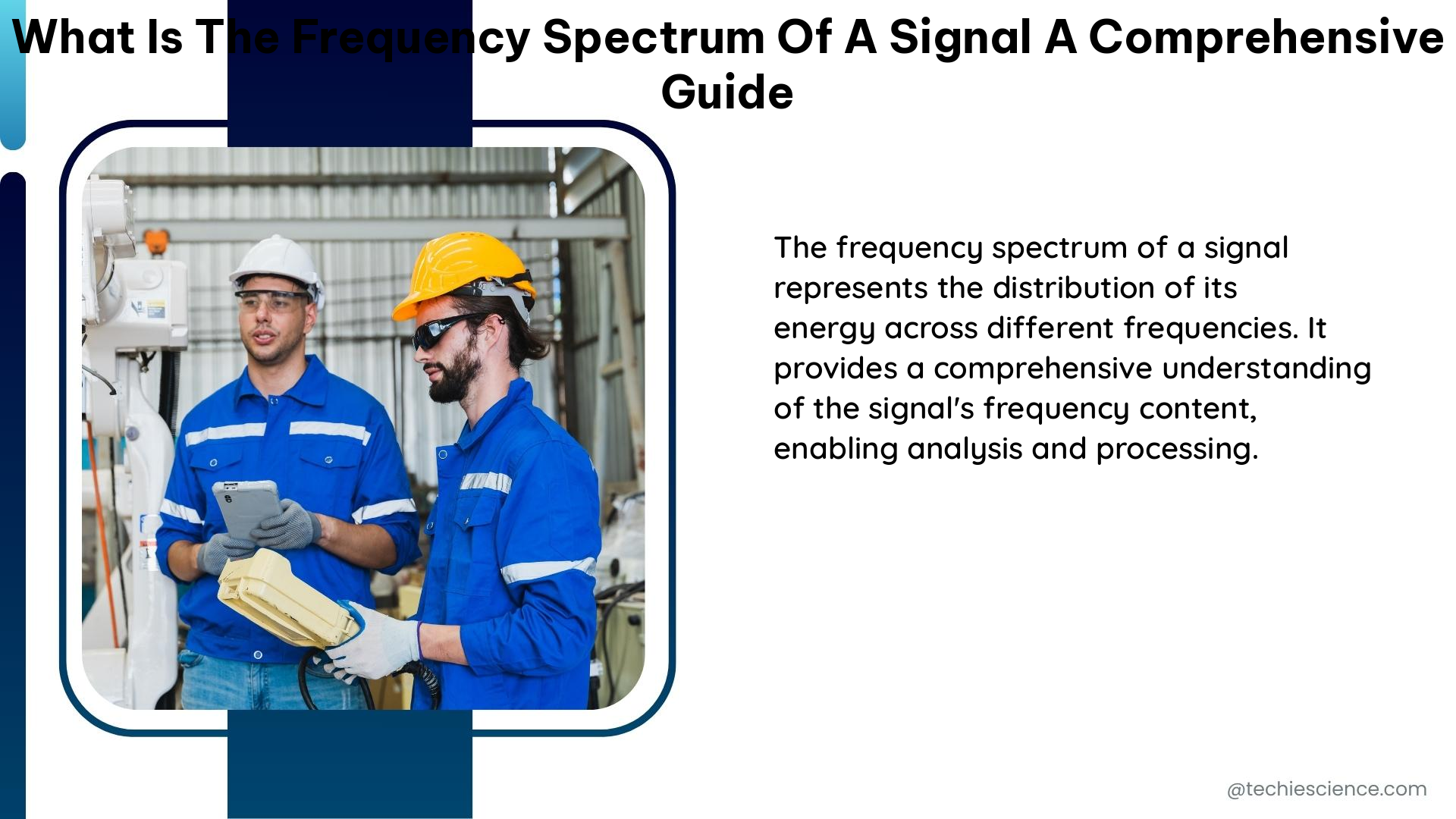The frequency spectrum of a signal is a crucial concept in signal processing, communication systems, and electronic systems. It represents the distribution of signal power as a function of frequency, providing valuable insights into the frequency components of a signal and their relative amplitudes.
Understanding the Frequency Spectrum
The frequency spectrum of a signal is a representation of the signal in the frequency domain, which can be obtained using the Fourier Transform. The Fourier Transform is a mathematical tool that transforms a time-domain signal into its frequency-domain representation, as defined by the equation:
X(f) = ∫_{-∞}^{+∞} x(t) * e^(-j2πft) dt
where X(f) is the frequency-domain representation of the time-domain signal x(t), f is the frequency variable, and j is the imaginary unit.
The frequency spectrum of a signal can be visualized using a frequency spectrum analyzer, which measures the signal strength over a range of frequencies and displays it as a graph. The x-axis of the graph represents the frequency, while the y-axis represents the signal amplitude or power.
Key Specifications of a Frequency Spectrum Analyzer

When measuring the frequency spectrum of a signal, there are several key specifications to consider:
-
Frequency Range: The frequency range is the range of frequencies that the analyzer can measure. Different analyzers have different frequency ranges, so it is essential to choose an analyzer that covers the frequency range of interest.
-
Resolution Bandwidth (RBW): The RBW determines the minimum width of a signal that the analyzer can resolve. A high RBW allows for more detailed readings of narrow signals, while a low RBW is better suited for reading broad signals. The RBW is given by the formula:
RBW = 1 / (2 * π * τ)
where τ is the time constant of the filter used in the analyzer.
-
Span: The span refers to the range of frequencies that the analyzer can measure. A wider span means the analyzer can measure a larger range of frequencies, which is helpful for troubleshooting or measuring signals with a wide frequency range.
-
Amplitude Range: The amplitude range is the difference between the largest and smallest signal that the analyzer can measure. A larger amplitude range means the analyzer can measure a broader range of signal strengths, which is crucial for accurate measurements of weak or powerful signals at different frequencies.
Measuring the Frequency Spectrum
To measure the frequency spectrum of a signal, the signal is first passed through a filter that separates it into its frequency components. The filtered signal is then amplified and fed into the analyzer, which measures the signal strength over a range of frequencies. The analyzer displays the frequency spectrum as a graph, which can be used to identify the frequency components of the signal and their relative amplitudes.
For example, let’s say we have a signal that consists of a 1 kHz sine wave with an amplitude of 1 V. We can measure its frequency spectrum using a spectrum analyzer with the following settings:
- Frequency Range: 0-2 kHz
- RBW: 10 Hz
- Span: 0-2 kHz
The display will show a peak at 1 kHz, corresponding to the frequency of the sine wave, with an amplitude of 1 V. We can also observe any harmonic distortion or noise in the signal by looking for peaks at other frequencies.
Frequency Spectrum Analysis Applications
The frequency spectrum of a signal can be used for various applications, including:
-
Troubleshooting: By analyzing the frequency spectrum of a signal, you can identify the presence of unwanted frequency components, such as noise or harmonics, which can help diagnose issues in the system that generated the signal.
-
Optimization: The frequency spectrum can be used to optimize the performance of electronic systems by identifying the critical frequency components and adjusting the system parameters accordingly.
-
Design: Understanding the frequency spectrum of a signal is crucial in the design of electronic systems, as it helps engineers select the appropriate components and filter configurations to achieve the desired signal characteristics.
-
Communication Systems: In communication systems, the frequency spectrum is used to allocate and manage the available frequency bands, ensuring efficient and interference-free signal transmission.
-
Audio and Video Processing: The frequency spectrum is widely used in audio and video processing applications, such as audio equalization, image enhancement, and video compression.
Conclusion
The frequency spectrum of a signal is a powerful tool for understanding the frequency components of a signal and their relative amplitudes. By using a frequency spectrum analyzer and understanding its key specifications, you can gain valuable insights into the behavior of electronic systems and optimize their performance. Whether you’re working in signal processing, communication systems, or electronic design, mastering the concepts of frequency spectrum analysis is essential for success.
Reference:
- Spectrum Analysis Basics – An Introduction
- Understanding Spectrum Analyzer Measurements
- How to Use a Spectrum Analyzer – Basics and Advanced Features

The lambdageeks.com Core SME Team is a group of experienced subject matter experts from diverse scientific and technical fields including Physics, Chemistry, Technology,Electronics & Electrical Engineering, Automotive, Mechanical Engineering. Our team collaborates to create high-quality, well-researched articles on a wide range of science and technology topics for the lambdageeks.com website.
All Our Senior SME are having more than 7 Years of experience in the respective fields . They are either Working Industry Professionals or assocaited With different Universities. Refer Our Authors Page to get to know About our Core SMEs.